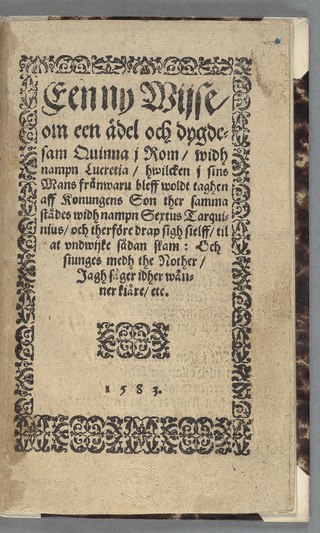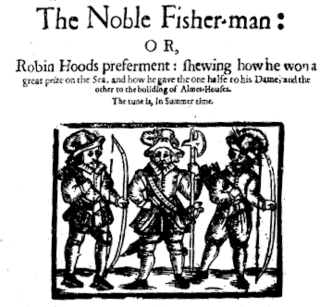Related Research Articles

Robin Hood is a legendary heroic outlaw originally depicted in English folklore and subsequently featured in literature and film. According to legend, he was a highly skilled archer and swordsman. In some versions of the legend, he is depicted as being of noble birth, and in modern retellings he is sometimes depicted as having fought in the Crusades before returning to England to find his lands taken by the Sheriff. In the oldest known versions, he is instead a member of the yeoman class. Traditionally depicted dressed in Lincoln green, he is said to have robbed from the rich and given to the poor.

A broadside is a single sheet of inexpensive paper printed on one side, often with a ballad, rhyme, news and sometimes with woodcut illustrations. They were one of the most common forms of printed material between the sixteenth and nineteenth centuries, particularly in Britain, Ireland and North America because they are easy to produce and are often associated with one of the most important forms of traditional music from these countries, the ballad.

The Merry Adventures of Robin Hood of Great Renown in Nottinghamshire is an 1883 novel by the American illustrator and writer Howard Pyle. Pyle compiled the traditional Robin Hood ballads as a series of episodes of a coherent narrative. For his characters' dialog, Pyle adapted the late Middle English of the ballads into a dialect suitable for children. The novel is notable for taking the subject of Robin Hood, which had been increasingly popular through the 19th century, in a new direction that influenced later writers, artists, and filmmakers through the next century.
Robin Hood's Chase is Child ballad 146 and a sequel to Child ballad 145, "Robin Hood and Queen Katherine". This song has survived as, among other forms, a late seventeenth-century English broadside ballad. It is one of several ballads about the medieval folk hero that form part of the Child Ballads, a comprehensive collection of traditional English and Scottish ballads.
"Robin Hood's Progress to Nottingham" is Child ballad 139, an original story that is part of the Robin Hood canon. This song has survived as, among other forms, a late 17th-century English broadside ballad, and is one of several ballads about the medieval folk hero that form part of the Child ballad collection, which is one of the most comprehensive collections of traditional English ballads.
Robin Hood and the Tanner is Child ballad 126. It is a late seventeenth-century English broadside ballad and one of several ballads about the medieval folk hero Robin Hood that form part of the Child ballad collection, which is one of the most comprehensive collections of traditional English ballads but has now been subsumed and surpassed by the Roud Folk Song Index.
Robin Hood and the Butcher is a story in the Robin Hood canon which has survived as, among other forms, a late seventeenth-century English broadside ballad, and is one of several ballads about the medieval folk hero that form part of the Child ballad collection, which is one of the most comprehensive collections of traditional English ballads. It may have been derived from the similar Robin Hood and the Potter.
Robin Hood's Golden Prize is Child ballad 147. It is a story in the Robin Hood canon which has survived as, among other forms, a late seventeenth-century English broadside ballad, and is one of several ballads about the medieval folk hero that form part of the Child ballad collection, which is one of the most comprehensive collections of traditional English ballads.

A Gest of Robyn Hode is one of the earliest surviving texts of the Robin Hood tales. Written in late Middle English poetic verse, it is an early example of an English language ballad, in which the verses are grouped in quatrains with an ABCB rhyme scheme, also known as ballad stanzas. Gest, which means tale or adventure, is a compilation of various Robin Hood tales, arranged as a sequence of adventures involving the yeoman outlaws Robin Hood and Little John, the poor knight Sir Richard at the Lee, the greedy abbot of St Mary's Abbey, the villainous Sheriff of Nottingham, and King Edward of England. The work survives in printed editions from the early 16th century, just some 30 years after the first printing press was brought to England. Its popularity is proven by the fact that portions of more than ten 16th- and 17th-century printed editions have been preserved. While the oldest surviving copies are from the early 1500s, many scholars believe that based on the style of writing, the work likely dates to the 1400s, perhaps even as early as 1400. The story itself is set somewhere from 1272 to 1483, during the reign of a King Edward; this contrasts with later works, which generally placed Robin Hood earlier in 1189–1216, during the reigns of King Richard and King John.
Robin Hood and the Bishop is number 143 in Francis James Child's collection of Child ballads, and describes an adventure of Robin Hood. This song has also survived as a late seventeenth-century English broadside ballad, and is one of several ballads about the medieval folk hero that form part of the Child ballad collection, which is one of the most comprehensive collections of traditional English ballads.

The Noble Fisherman, also known as Robin Hood's Preferment and Robin Hood's Fishing, is a 17th-century ballad of Robin Hood. Unusually, it depicts Robin Hood as a hero of the sea, rather than his usual portrayal as someone who operated in the greenwood forest. It seems to have been quite popular for the first two centuries of its existence, although it eventually lost prominence and was less used in adaptations of Robin Hood from the 19th and 20th centuries. It was later published by Francis James Child in the 1880s as Child Ballad #148 in his influential collection of popular ballads.

Robin Hood and the Monk is a Middle English ballad and one of the oldest surviving ballads of Robin Hood. The earliest surviving document with the work is from around 1450, and it may have been composed even earlier in the 15th century. It is also one of the longest ballads at around 2,700 words. It is considered one of the best of the original ballads of Robin Hood.
King Edward the Fourth and a Tanner of Tamworth is a ballad first found in the Child Ballad collection, number 273. A ballad of this title was licensed in 1564. Versions of this ballad also exist outside the Child collection. Additional copies can be found at the British Library, the University of Glasgow Library, and the Pepys Library at Magdalene College. These ballads dates, by estimation of the English Short Title Catalogue, range from the early seventeenth century to as late as 1775. The ballad is most recognized by its opening line: "In summer time, when leaves grow green." Child describes the appeal of this ballad to be centered on the chance meeting with a King, which is also a recurring theme in tales of Robin Hood.
Robin Hood and the Shepherd is a story in the Robin Hood canon which has survived as, among other forms, a late seventeenth-century English broadside ballad, and is one (#135) out of several ballads about the medieval folk hero that form part of the Child ballad collection, which is one of the most comprehensive collections of traditional English ballads.
"Robin Hood and the Beggar" is a story in the Robin Hood canon which has survived as, among other forms, a late seventeenth-century English broadside ballad, and is a pair out of several ballads about the medieval folk hero that form part of the Child ballad collection, which is one of the most comprehensive collections of traditional English ballads. These two ballads share the same basic plot device in which the English folk hero Robin Hood meets a beggar.
An itinerant poet or strolling minstrel was a wandering minstrel, bard, musician, or other poet common in medieval Europe but extinct today. Itinerant poets were from a lower class than jesters or jongleurs, as they did not have steady work, instead travelling to make a living.

Robin Hood and Little John is Child ballad 125. It is a story in the Robin Hood canon which has survived as, among other forms, a late seventeenth-century English broadside ballad, and is one of several ballads about the medieval folk hero that form part of the Child ballad collection, which is one of the most comprehensive collections of traditional English ballads.
The English Broadside Ballad Archive (EBBA) is a digital library of 17th-century English Broadside Ballads, a project of the English Department of the University of California, Santa Barbara. The project archives ballads in multiple accessible digital formats.

Holland's Leaguer was the name of a Dutch English brothel in London between 1603 and January 1632. It has been referred to as the most famed brothel in 17th-century England. "Legeur" means military encampment.
References
- ↑ Francis James Child (1898). English and Scottish Popular Ballads. Boston, Massachusetts, USA: Houghton, Mifflin and Company . Retrieved 12 August 2012.
- ↑ Watt (1993) , pp. 39–40
- ↑ Watt (1993) , pp. 39–40, quoting Edward Dering, A brief and necessary instruction (1572), sig.A2v.
- ↑ Child (2003) , p. 42
- ↑ Brown (2010) , p. 67; Brown's italics
- 1 2 Brown (2010) , p. 69
- 1 2 Fumerton & Guerrini (2010) , p. 1
- ↑ Holt (1989) , pp. 37–38
- ↑ Holt (1989) , p. 10
- ↑ Singman (1998) , p. 46, and first chapter as a whole
- ↑ "Ballad Archive Search - UCSB English Broadside Ballad Archive". Ebba.english.ucsb.edu. Retrieved 2015-06-02.
Bibliography
- Brown, Mary Ellen (2010). "Child's ballads and the broadside conundrum". In Patricia Fumerton; Anita Guerrini; Kris McAbee (eds.). Ballads and Broadsides in Britain, 1500–1800. Burlington, VT: Ashgate Publishing Company. pp. 57–72. ISBN 978-0-7546-6248-8.
- Child, Francis James, ed. (2003) [1888–1889]. The English and Scottish Popular Ballads. Vol. 3. Mineola, NY: Dover Publications.
- Fumerton, Patricia; Guerrini, Anita (2010). "Introduction: straws in the wind". In Patricia Fumerton; Anita Guerrini; Kris McAbee (eds.). Ballads and Broadsides in Britain, 1500–1800. Burlington, VT: Ashgate Publishing Company. pp. 1–9. ISBN 978-0-7546-6248-8.
- Holt, J. C. (1989). Robin Hood. Thames and Hudson. ISBN 0-500-27541-6.
- Singman, Jeffrey L. (1998). Robin Hood: The Shaping of the Legend. Greenwood Publishing Group. ISBN 0-313-30101-8.
- Watt, Tessa (1993). Cheap Print and Popular Piety, 1550–1640. Cambridge Studies in Early Modern British History. Cambridge University Press. ISBN 9780521458276.